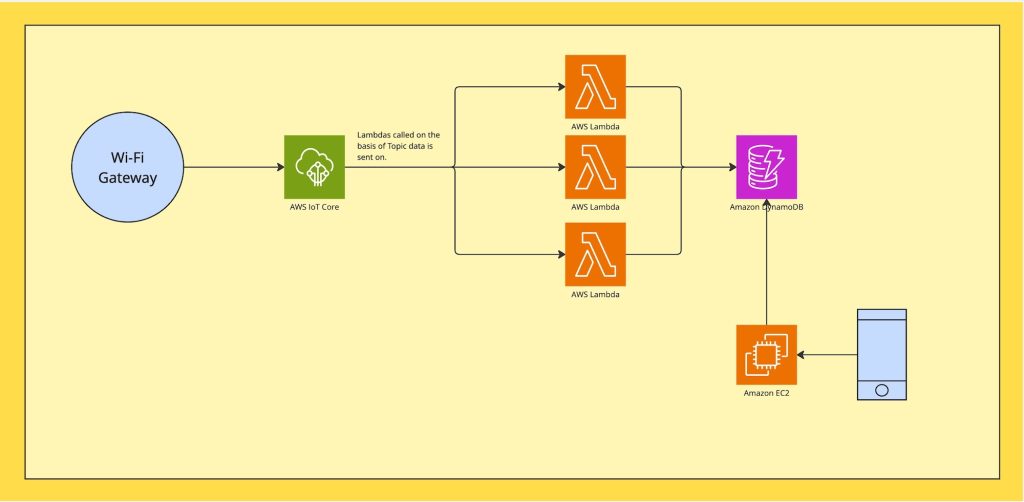This case study highlights the successful optimization of an IoT project, where we deployed more than 400,000 devices in the field, continuously transmitting data to the cloud for real-time monitoring. By implementing strategic cloud optimizations and leveraging AWS services, we achieved a 50% cost reduction while increasing system efficiency by 30%.
Project Background
Our IoT deployment involved two types of devices:
- Bluetooth Device: Collected data and transmitted it via Bluetooth to either a mobile phone/tablet or a second device.
- Wi-Fi Gateway Device: Connected to the Bluetooth device, fetched data on-demand or at set intervals, and synced data over MQTT to the cloud.
Initially, the system design had significant inefficiencies in data storage, processing, and cloud resource utilization. These inefficiencies led to high costs and latency issues, prompting the need for a system-wide optimization.
Challenges
- Database Bottlenecks: Initially, all data was stored in MySQL, leading to high query execution times and increased database overhead.
- Inefficient API Hosting: APIs were hosted on EC2 instances, contributing to unnecessary server costs and traffic overhead.
- Scalability & Real-time Processing Issues: Handling 400,000+ devices required a scalable and efficient cloud infrastructure.
- High Cloud Costs: Due to inefficient service allocation and utilization.

Optimization Strategies Implemented
1. Database Optimization: Transition to DynamoDB
- Migrated from MySQL to Amazon DynamoDB, enabling efficient handling of large-scale real-time data ingestion.
- Reduced database overhead by structuring JSON data efficiently, ensuring that queries were optimized for rapid retrieval.
- Implemented automated indexing and partitioning strategies to reduce query times and enhance read/write performance.
- Leveraged AWS IoT Core Rules to segregate data before storing it in DynamoDB, eliminating unnecessary processing.
2. Serverless Architecture Implementation
- Transitioned from EC2-based APIs to AWS Lambda with Serverless Framework, reducing the need for always-on servers.
- Used API Gateway to handle API requests, dynamically routing calls to Lambda functions, leading to reduced operational costs.
- Implemented provisioned concurrency for Lambda to reduce cold start times and ensure near-instant execution.
- Set up event-driven execution, meaning computing resources were only used when needed, rather than constantly running EC2 instances.
3. MQTT-Based Data Segregation & Processing
- Configured AWS IoT Core as the MQTT broker, efficiently handling device communication without persistent connections.
- Implemented IoT Core rules to filter and segregate data based on topics before storing it in DynamoDB.
- Designed real-time processing workflows where specific topics triggered Lambda functions for notifications, analytics, and custom processing.
- Implemented QoS (Quality of Service) levels for MQTT messages to ensure reliable data transmission with minimal overhead.
4. Query Optimization & Caching
- Optimized database queries to retrieve only necessary data, significantly reducing read latencies and improving application response times.
- Introduced Redis caching to store frequently accessed data, reducing the load on DynamoDB and improving retrieval times.
- Implemented Aurora RDS read replicas for relational data, ensuring a scalable and high-availability solution for data storage.
- Used edge caching via AWS CloudFront, reducing response times for users accessing data from different locations.
5. Load Balancing & Auto-Scaling Optimization
- Implemented AWS Auto Scaling Groups to dynamically adjust EC2 instances based on demand.
- Configured Application Load Balancers (ALB) to distribute traffic efficiently across multiple instances, ensuring high availability.
- Optimized Nginx configurations to handle the maximum number of requests per server, reducing the need for additional instances.
- Designed an elastic scaling strategy where instances increased during peak loads and were automatically terminated when traffic decreased.
6. Cost Optimization Measures
- Eliminated underutilized EC2 instances, reducing server costs and shifting to Lambda-based execution.
- Utilized AWS Auto Scaling to dynamically allocate resources based on demand, ensuring cost efficiency without performance degradation.
- Implemented reserved instances and savings plans for AWS services, reducing long-term operational costs.
- Optimized network bandwidth usage by compressing and batching IoT data before transmission, reducing data transfer costs.

Results & Impact
🔹 50% Cost Reduction
- Eliminating unnecessary EC2 instances and leveraging AWS Lambda significantly cut down operational expenses.
- Optimized database storage and query execution led to reduced RDS costs.
- Efficient IoT data handling prevented unnecessary cloud resource consumption.
🔹 30% Increase in System Efficiency
- Real-time data processing using AWS IoT Core & Lambda improved response times.
- Faster query execution and caching strategies enhanced system performance.
- Optimized serverless execution reduced latency for API calls and real-time operations.


